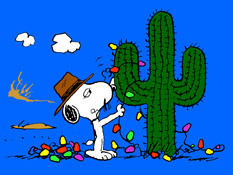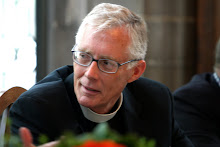Gary Hall
Washington National Cathedral
December 25, 2014 [Christmas Day]

One
of the most important spiritual practices I have at this time of year involves
a big glossy book by Charles Schulz called, A
Peanuts Christmas. It’s a collection of all the Peanuts Christmas cartoons.
Whenever I need to get myself into the spirit of Christmas, I take this
book down from the shelf and read it straight through. And if there was ever a
December when I needed Charlie Brown and his friends, this has been it.
I
have been reading Peanuts with some
regularity since I was in fourth grade. I say this neither apologetically nor
proudly. Something about that comic
strip helps me make sense of my experience of the world. In that sense, Peanuts is a bit like the Bible.
And like my engagement with the Bible, every time I read Peanuts I see something new. When I was younger I empathized with Charlie
Brown, then with Linus. These days I’m
more of a Snoopy kind of guy. But this
year, for some reason, my heart has gone out to Spike.
Now
for those of you who are not current on the Peanuts
cast of characters, Spike is Snoopy’s ne’er-do-well brother who lives in the
desert. Originally there were four brothers at the Daisy Hill Puppy
Farm—Snoopy, Andy, Olaf, and Spike. (For you purists, there are also some
forgotten siblings: another brother,
Marbles, and a sister, Belle. Molly and
Rover appeared in a TV special, but never in the comic strip. ) This is sounding
nerdy, so I’ll move on.
Anyway: this year I’ve been thinking a lot about
Spike. He lives in the desert next to a
cactus he has named, “Joe Cactus”. Spike
wears a hat and sports a little moustache—he looks a bit like a 1940s racetrack
tout. Every year he decorates Joe Cactus
with electric lights, a stocking, and a star. Spike settled on the cactus after
other experiments. As he says, “It’s
hard to decorate a rock.”
Now
there are probably lots of hidden reasons why I return to Peanuts at this time every year, but at least one of them is that
this comic strip consistently expresses the deepest truths about Christmas.
Whether it’s Linus reading Luke’s Christmas Gospel in the pageant, Sally writing
acquisitive letters to Santa, or Spike decorating a cactus and a rock, Charles
Schulz knew how to represent our experience of the season. All alone in his hat and his cactus in the
desert, Spike shows us that Christmas can be anywhere.
Today’s
Gospel, from the first chapter of John, makes that same point, admittedly in
fancier language:
In
the beginning was the Word, and the Word was with God, and the Word was God. He
was in the beginning with God. All things came into being through him, and
without him not one thing came into being. What has come into being in him was
life, and the life was the light of all people. The light shines in the
darkness, and the darkness did not overcome it. [John 1: 1-5]
The Prologue to John’s
Gospel (as this passage is called) is at once beautiful and confusing. It is trying to tell us something deeply true
about God, us, and the world. It does so
in abstract, poetic, theological language.
And each time I hear it read, I have a dual response to it: “Gosh, that’s beautiful,” and “Huh?” In that
respect, hearing the opening verses of John’s Gospel is like watching Spike put
Christmas decorations on a cactus. It’s
compelling and weird at the same time.
But if you hold that image
of Snoopy’s brother celebrating Christmas in the desert while you listen to
John’s opening verses, you get a sense of what this holiday celebrates. In lofty language: John is telling us that
the One at the center of the universe is present here and among us in the
world. In plain speak: Christmas can be
anywhere.
Because I don’t want you to
leave the cathedral thinking that cartoon collections make up the sum of all
the dean’s intellectual engagement, I
want to add that this Advent I’ve also been reading Barbara Brown Taylor’s new
book, Learning to Walk in the Dark.
Equating God with light is an old Christian habit. As John says, “The light shines in the
darkness.” But there is an equally
ancient Christian tradition of finding God in the dark. Light is clarity. Dark is mystery. As Saint Augustine said, “We are talking about God. What
wonder is it that you do not understand? If you do understand, then it is not
God.” Ever since the Enlightenment, our
Western minds have reached for illumination as an aspect of God. But there is a long Christian tradition of finding the
divine in the shadows, a practice Barbara Brown Taylor calls “learning to walk in the dark.”
“We are talking about God. What wonder is it that you do not
understand? If you do understand, then it is not God.” When we are honest with ourselves, we
acknowledge that there is much of life and the world that we do not
understand. There is much about
Christianity that we do not understand.
The Prologue to John’s Gospel, the Nicene Creed, many of Jesus’s sayings
and parables—so much of what we profess eludes our understanding. And yet, year after year, we come back to
this moment of Christmas because it says something to us that our minds cannot
fathom but our hearts somehow can grasp.
Spike puts ornaments on a cactus in the desert. Christmas can be anywhere. “We are talking about God. What wonder is it
that you do not understand? If you do understand, then it is not God.” Perhaps the Prologue to John’s Gospel sounds
mysterious precisely because John is trying to go around our intelligence. As Barbara Brown Taylor says, the real
questions of life and faith are not questions of abstract belief. The real ones sound like this: “On what is your heart set?” “What powers do you most rely on? What is the hope that gives meaning to your
life?” And she adds, “The answers to [those questions] are not written down in
any book, and they have a way of shifting in the dark.” [Learning to Walk in the Dark, p. 144]
“On what is your heart set?” Spike’s heart is set on a
cactus, Snoopy’s on a little bird named Woodstock, Charlie Brown’s
on winning at least
one baseball game. In his own difficult yet beautiful way, the writer of John’s Gospel is telling us that the answer to
what we set our hearts on is the real meaning of Christmas. As he tells us,
And
the Word became flesh and lived among us, and we have seen his glory, the glory
as of a father’s only son, full of grace and truth. No one has ever seen God.
It is God the only Son, who is close to the Father’s heart, who has made him
known. [John 1: 14,18]
“We
are talking about God. What wonder is it that you do not understand? If you do
understand, then it is not God.” When it
comes right down to it, I don’t understand the Prologue to John’s Gospel any better than
you do, but I do know that something in it speaks to what my heart is set on.
In the birth of Jesus, we have been shown and given everything about God
that can be grasped. God is elusive,
mysterious, dark. We cannot own or
control God. No church can give you an
ironclad guarantee that we have God all figured out and packaged in a neat,
dependable way. Yet every Christmas
morning we rejoice that this One whom we can neither grasp nor understand
became one of us in Jesus and now lives among and in us as “the true light that
enlightens everyone” [John 1:9].
If
God can be both darkness and light then I really don’t understand it. And if I don’t understand it, then it just
might be God we’re talking about. And that is good news.
If you’re in a dark confused part of your life right now, the Christmas
word today is that God is coming to you right in that dark, confused, possibly
grieving or fearful or wounded place. Christmas can be anywhere.
Jesus
is born in Bethlehem. Light shines in
the darkness. The Word became flesh and
dwelt among us. Christmas can be anywhere, even
in the parts of yourself and your life you don’t acknowledge or understand. God
is in and with and among us. You, your
life, your relationships, your world have divine significance. That’s the Christmas Gospel, and I can’t
quite figure out how it works, either.
But I know it’s the truth, because when we hear it, our hearts know it’s what they are set on.
So
go ahead and decorate
a rock. Put a star on a cactus. And Merry
Christmas. Amen.


No comments:
Post a Comment